#yakumo haruko
Text
Good analysis https://dustspeckintheuniverse.home.blog/2017/03/26/rakugo-shinjuu-dissecting-the-final-reveal/
5 notes
·
View notes
Text
I read the Shouwa Genroku Rakugo Shinjuu manga. I’ve been interested in reading it ever since I watched the anime two years ago, but I wanted to give it some time first. Then it was difficult to start because of how heavy it gets, but once I did I finished it in a few days.
The anime is a very faithful adaptation, but the manga is worth reading to experience the story again and to see how the original presents it. You’ll also be able to admire all of the charming expressions Haruko Kumota draws, which is one of the manga’s biggest strengths.
Knowing the story from before I was able to pay more attention to the smaller details and parallels. I didn’t remember how much the characters revealed and processed through rakugo and I enjoyed being able to keep better track of who told which stories when, and what memories or feelings would be brought up when those stories would be told again. I gained a deeper understanding of all the main characters, especially how much Yotaro did for Yakumo and Konatsu and how he helped them.
It’s amazing how much the story and characters repeat themselves, to a degree of being scary and damaging, but it’s also part of the charm and showcases the passion these characters have for rakugo, which I adore.
I still love how the story is structured and how realistically flawed the characters are. I’m not completely sold on the “official” romances, I find them a little hard to believe, but I like how many complex relationships we get and how much they affect the characters.
I want to watch the anime again sometime. I don’t want to compare the manga to the anime too much, and I know the anime got the benefit of being the first medium in which I experienced the story, so the tension ran higher and the reveals left a bigger impact, but what left an even bigger impact was the voice acting. I think Akira Ishida’s performance as Yakumo might be my favourite seiyuu performance of all time. Yuu Kobayashi is another favourite seiyuu of mine, it’s always a delight to listen to her and she was perfect as Konatsu. The anime was able to bring the rakugo performances to life and made them shine more than in the manga. I also think they built up the mystery and its reveal better, and had better pacing, but I might be misremembering. Either way I highly recommend both the anime and the manga.
21 notes
·
View notes
Text
I love Showa Genroku Rakugo Shinju so, so much. It’s been a pleasure to rewatch slowly with friends on Tuesdays as the filling in our Anime Girls’ Night programming block.
We finished the first season tonight and one thing that stands out to me is that on Yakumo and Konatsu being forced to become each other’s family, there’s the heartwarming story arc of a grumpy, isolated person becomes more open and softens with the love and spontaneity of a child. You know that’s a popular narrative trope in Japan; see the popularity and success of anime adaptations of Anne of Green Gables and Heidi.
Haruko Kumota’s decision to instead have them basically deepen their already existing issues and draw lines of pure antagonism, with Konatsu vowing to stick around to kill Yakumo, and Yakumo going “oh please if you’re going to hurry up so I can escape the hell that is being alive” is a beautiful and perfect one.
2 notes
·
View notes
Text
SGRS MANGA EXTRAS


Its seems like Shinnosuke is starting to realize that this mysterious young man is actually his JII JII (grandpa) after all.
#shinnosuke#showa genroku rakugo shinju#shouwa genroku rakugo shinjuu#sgrs#sgrs spoilers#sgrs 2#manga spoilers#manga screenshots#manga series#manga scan#haruko kumota#yuurakutei yakumo#Yakumo Yurakutei#kikuhiko#kumoto haruko#manga caps#manga related
118 notes
·
View notes
Photo
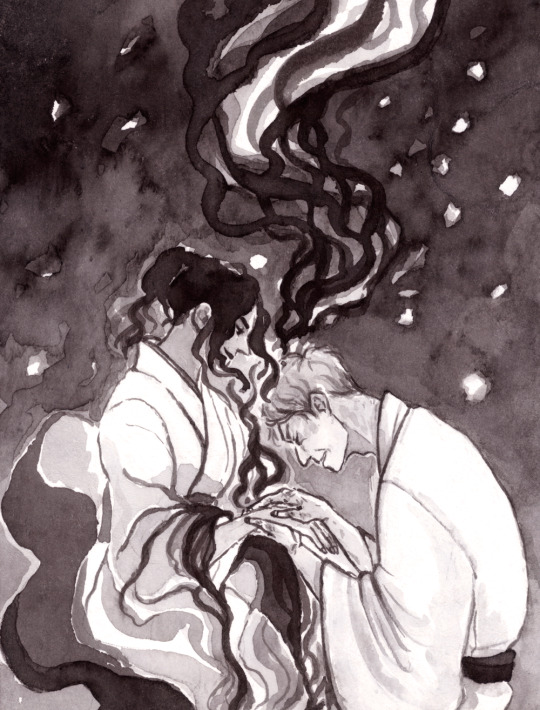
and at your final end
when you are free again
no longer long to be
you will belong to me
your ghost, oh, your ghost
#shouwa genroku rakugo shinjuu#kumota haruko#yuurakutei yakumo#miyokichi#inktober#inktober 2020#ink#your ghost#the decemberists#i'm in pain
216 notes
·
View notes
Photo

Your hair’s getting long. I’ll cut it for you.
#rakugo shinjuu#kikuhiko#yakumo#bon#Shouwa Genroku Rakugo Shinjuu#descending stories#Kumota haruko#manga#sgrs#rakugo
45 notes
·
View notes
Text
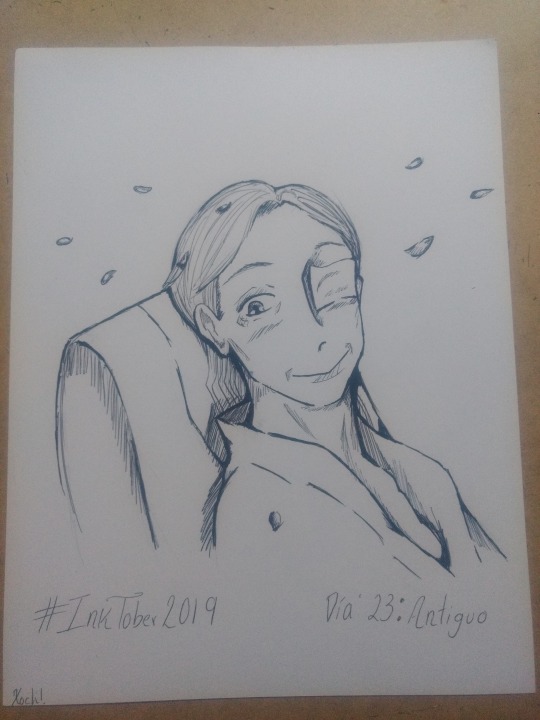
Cuando era joven... Cuando era joven, aunque amase a una chica, nunca podría decírselo. Me lo guardaba en el corazón hasta que enfermaba por ello. Pero, si vas a enfermar por amor, que sea por una hermosa mujer.
#kikuhiko#kikuhiko yurakutei#yakumo yukari#yakumo#bon#shouwa genroku rakugo shinjuu#shouwa#SGRS#sgrs#kumota haruko#inktober2019#inktober#dia 23
8 notes
·
View notes
Photo
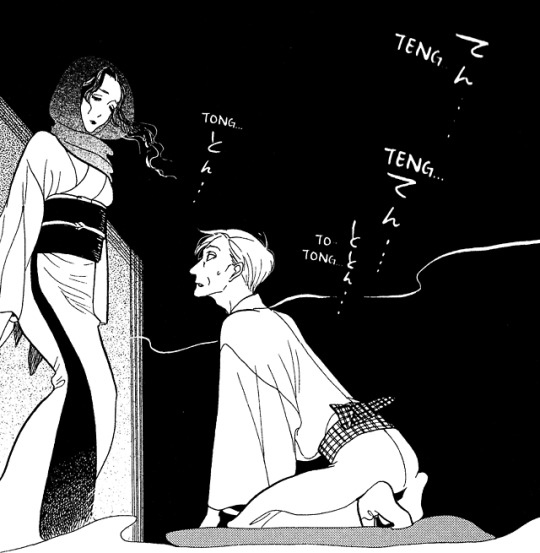
昭和元禄落語心中 (Shouwa Genroku Rakugo Shinjū), Haruko Kumota
40 notes
·
View notes
Text
Shouwa Genroku Rakugo Shinjuu
Descending Stories: Showa Genroku Rakugo Shinju

My Summary:
A historical manga which involves the art of story-telling (rakugo) and the hardships of maintaining an audience whilst involving relationships and emotional rollercoasters. (For those who may not know I am a die-hard fan of slice of life and somewhat historical manga, I really enjoyed the vibes given off by this series). I may point out too, that I did not read the manga but watched both seasons.

Synopsis:
The Story starts with the release of a young man from prison. He immediately heads off to meet a famous rakugo performer. He begs the performer to make him his apprentice due to his ongoing admiration for the rakugo performer since he had once performed the “Shinigami” Act for the prisoners. The story focuses on the backstories of the performers and their struggle to gain popularity throughout different eras and featuring different generations of story-tellers.

My Review:
I really fell in love with the setting, especially the whole Edo Period scenery and vibes. There are three generations of story-tellers featured throughout the series. Starting with Kikuhiko, going down to Yotaro and jumping back to Yakumo. Each of the generations relate to hardships they have been going through and expose their emotions and ambition towards rakugo. Personally, I had no knowledge of rakugo when I started the series so it might have been quite boring for me, but it turned out to be such a captivating show with the carefully narrated story and pleasing side characters which in suk contributed to such a great plot. Also the story progresses slowly but does not fail to set a climax at different points of the series. Hence, I really took a liking to both seasons and of course to the main character Kikuhiko (later Master Yakumo) which turns out to be a rather caring human being beneath his cold hearted appearance and behaviour.

#anime#suggestion#animetowatch#manga#historicalmanga#sliceoflife#shouwa genroku rakugo shinjuu#descendingseries#konatsu#yakumo#yotaro#sukeroku#rakugo#haruko kumato#season 1
8 notes
·
View notes
Photo


Hey, Bon
You liked rakugo, and you loved people.
And you lived a full life.
Thanks to you, i can move on, too.
We'll meet again, someday.
Pinky Swear
#shouwa genroku rakugo shinjuu#bon#kikuhiko#sukeroku#yuurakutei yakumo#sgrs#sgrsedit#[B!edits]#*cries a river*#kumota haruko
480 notes
·
View notes
Photo
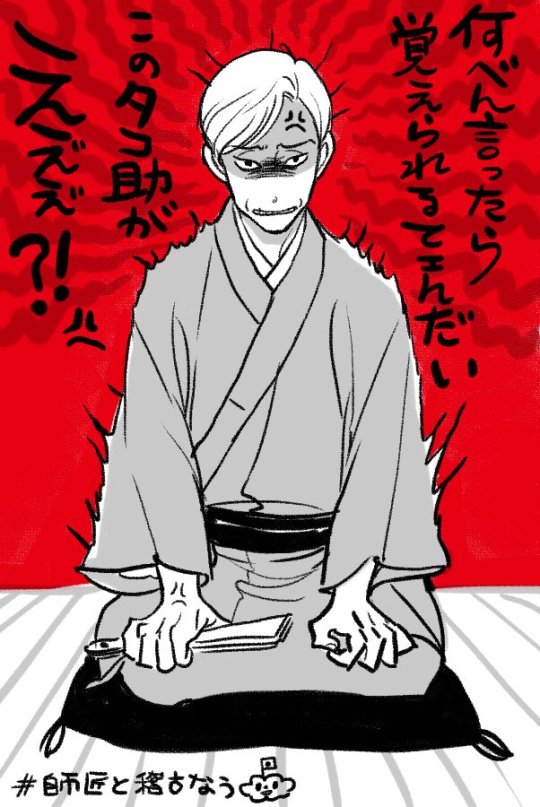
6/5 was Rakugo Day!!
Get ur Box Sets for the DVD/BD !!! They’ve been released !!
#shouwa genroku rakugo shinjuu#showa genroku rakugo shinju#kumota haruko#yuurakutei yakumo#kikuhiko#sgrs
160 notes
·
View notes
Photo
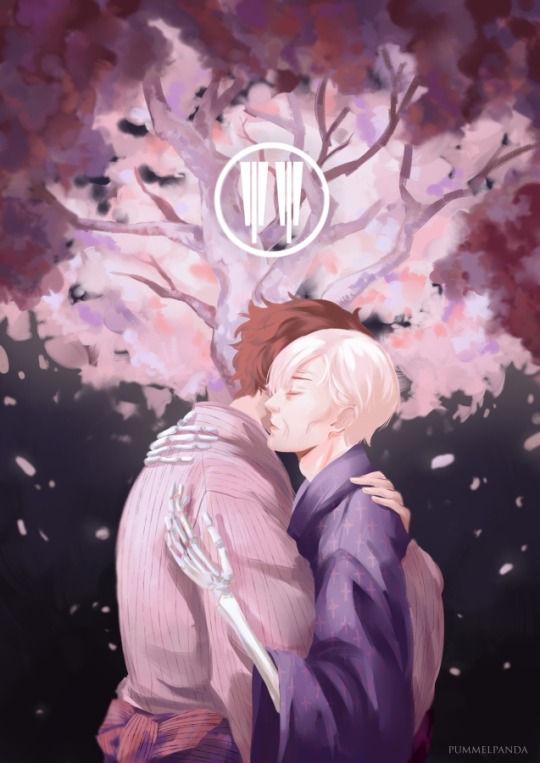
Not only last season's highlight, but one of my all time favourites.
#shouwa genroku rakugo shinjuu#sukeroku yuurakutei#yakumo yuurakutei#kumota haruko#Fanart#Pummelpanda draws
669 notes
·
View notes
Text
Thinking of anime - Descending Stories: Showa Genroku Rakugo Shinjuu by Haruko Kumota Part 2

The first disciple of Yakumo, Yotaro. Often in Rakugo, the foolish characters are named Yotaro
In part 1, I gave you a general introduction of the series Showa Genroku Rakugo Shinjuu (SGRS). From here on, I shan’t explain in-depth the story and the characters as my intent here are not in recommending this anime. People who watch it will watch it and those who will fall in love with this story will share what they love. And it is this love that binds the community as a whole.
I want to start off by having some working definitions of technical words that will be used.
Let’s start off with culture. We use this word often in our daily lives and it is strongly ingrained in our vocabulary; it is something we know the meaning of, but not many can give the definition to. This tends to happen as culture is used as an umbrella term to encompass social behavior, norms, knowledge, beliefs, objects, and so on of a group of individuals. It is something that is fluid and changes over time.
Cultural practices are performed largely to arrange the social relations and relations of production in a certain way. This method of arrangement can be of necessity or arbitrary and can be fluid but also cemented with something more solid then culture. When cultural practices are cemented it becomes comparatively unaffected and can resist changes brought on by the fluidity of culture around; becoming traditional practices. Often those practices lose meaning that was attached to it during this transition and it becomes a free ground for meaning to be created by its practitioners, and audiences.
Performativity is a term that many will be familiar with through Judith Butler’s use of the term gender performativity. But I’ll use it here in the context of traditional practices; cultural performativity; that it is through the repeated performance that such practices, even after losing its function of social organization can it survive; it is the continued practice that results in the tradition being kept alive, rather the tradition dictating the actions that are performed.
Framing tradition as something that is kept alive by repeated performance rather than a monolithic set of rules, allows us to find ways to alter it as the culture around it changes; co-existing with progress. There is a view in our world today that dims tradition as harmful to progress. There is also an opposite spectrum of this view that tries to use traditional value as a device to create us vs them divide and a different way of seeing tradition may help us preserve the meaning people attach to it, while it serves to better, not jeopardize our society.
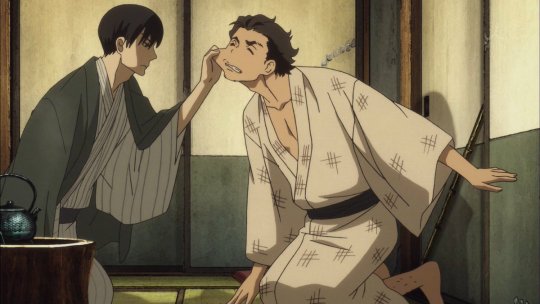
The two brother disciples, platonic but also loving relationship
Let’s recap what is my belief that the author wants to convey to us which are: What does it mean to hold affection? And how does affection of the past influence our interaction with the world that changes?
The whole of season 1, except for the very first episode, depicts the life of Yakumo (or Bong at this point) in his earlier days. It starts with an introduction of him when he was seven years old and sent off to study Rakugo under the then seventh-generation Yakumo. On his first day as a disciple, he meets Sukeroku, who becomes his brother by discipleship. During their interaction, we learn of how Bong felt abandoned by his parents who sent him off to Yakumo as they did not want him as their son.
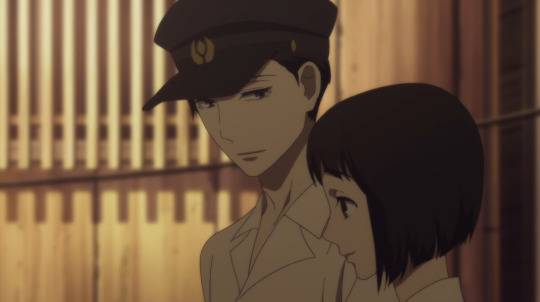
Bong in his first romantic relationship
We then skip forward a few years to his teenage years, Bong, due to the fear of being abandoned again, desperately holds onto Rakugo, hoping that if he were to get good enough, it would become a place where he could belong. This becomes an obsession and he becomes blind to other places to belong; where he can find solace. Namely, this is shown as a girl that he meets and falls in love with, yet due to Bong’s obsession with his practice, they drift apart.
After graduating from mandatory education, Bong receives the name of Kiku and along with Sukeroku, begins to perform properly on stage as a full-time Rakugoka. During this period, Kiku puts in great effort into his practice yet always lacks behind Sukeroku. Yet Sukuroku’s free nature prevents him from adhering to the restrictive rules of tradition and this makes him disliked by the elder members of the practice.
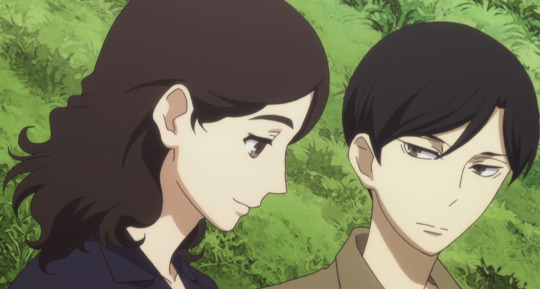
The last chance for a simpler life
Japan soon becomes embroiled in various wars and this led to a period of restraint; a period where people avoid wasting resources so that it can be directed towards the war, this has a direct impact on entertainment industries, and Rakugo as well. As time passes and the war continues, Kikuhoko’s teacher and Sukeroku travel to Manchuria to perform for the soldiers on the front lines while Kiku is unable to follow them due to the problem of his leg.
During this period, he moves to the countryside and works in a factory, this slow life allowing him to contemplate if he should just stay there and not return to the busy city to practice Rakugo. Here, he had a chance to find another way of life, free from his obsession with Rakugo, and try to find meaning in something else.
The war eventually ends, and he returns to Tokyo. As society begins to recover from the damages of war, people begin to seek out entertainments and Kiku returns to practicing Rakugo to earn a living. Eventually, his teacher and Sukeroku make it back to Japan and everyone is happy and reunited.

Miyokichi flirts with Kikuhiko, but Kiku is not sure
Here we are introduced to Miyokichi and she quickly takes a liking of Kiku, falling in love with him. This time Kiku does reciprocates, even if his priority is always with practicing Rakugo, and for a while, Miyokichi is okay with this, she is happy seeing the person she loves happy and knows what it is that they want to achieve in life.

Different camera works are employeed to show the different
While Kiku was devoted to his practice, Sukeroku’s disdain for tradition grows. In the words of the characters, the two are compared in their way of performance. For Kiku, he embodies the characters and brings the audiences into the world that is being told; he is fluid in his selfhood when performing and tells the story as it is, as close as possible to its intention. Sukeroku is the opposite. All the characters become Sukeroku as he tells the story. He follows the general structure, but his method of delivery is unique to himself and how he feels at that moment; he is unstable but his leads to uniqueness in his telling of the story. If people watch Kiku to listen to the stories he tells, they watch Sukeroku to enjoy Sukeroku’s performance.
The audience loves them for their individual styles, but Sukeroku’s style makes him shine out compared to the older generations and this results in him increasingly losing favor from the senior practitioners. Yet he was kept around since the audiences liked him, but as his fame increased so did his ego. This eventually results in him being excommunicated from his teacher.

Westernisation of entertainment in Japan, post-pacific war
And yet if we were to see his actions from a different perspective, we can see this as another form of struggle to keep the practice of Rakugo alive. At this point in history (and depicted in the series), Japan had been experiencing westernization of culture. Kiku works in a café, there is a jazz bar, and Rakugo has been losing its audience as time went by.
The two characters, Sukeroku and Kiku were the youngest practitioners; at least among those, we are introduced to. Thus the two promise each other to continue the practice, to keep it alive, and attempt to revitalize it. To them, Kiku who told the stories as they were would symbolize the tradition that has continued down for centuries, While Sukeroku would symbolize the constant change that is needed for the continued existence of the culture; thus they are not lost to the tide of time; they make a promise to both work together and keep the practice they love alive.
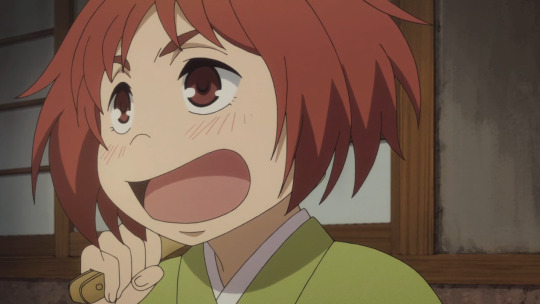
Konatsu. The daughter of Miyokichi and Sukeroku. She shows us just how many years passed since they ranaway
Yet this promise is left unkept. After Sukeroku’s excommunication, and Kiku’s rejection of Miyokichi’s advances, the two run away from the city to the countryside, have a child and start a family together. However, due to her rejection by Kiku, Miyokichi prevents Sukeroku from practicing Rakugo, as he did not have any other skills, he was unable to earn a living and became a drunk. Fed up with this, she runs away, leaving him and their daughter Konatsu. This belief becomes an obsession and she becomes delusional that Kikuhiko will one day come to save her from this misery.
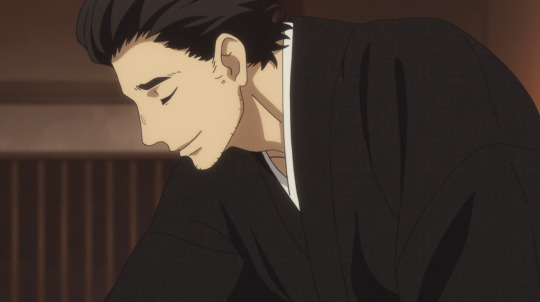
Sukeroku: “No, I won’t drink this Sake. I don’t want this to have been just a dream”
While this was happening, Kiku became better accepted by the senior members of the practice and built up enough fame to the point that there were people who wanted to be his disciple. However, to Kiku, Rakugo that has now lost Sukeroku to guide it to the future is only left to wither away and die. The more he believed this, the more convinced he was that his role was to see it off to the end.
Yet he holds out hope that if he was just able to bring Sukeroku back, things might change. And after his teacher’s passing, he journeys out in search of him. He finds him eventually, and with effort was able to bring Sukeroku out of his drinking habit and bring him back to performing Rakugo, first at the nearby inn. The performance was successful and for a moment we see the possibility for their promise being kept. Sukeroku wants to go back to the city with Kiku, and start performing Rakugo again as a profession, the reason, not the least of which, the love his daughter shows for his performance.

Did this really happen?
Yet all goes astray when Miyokichi returns that exact night for Kiku and her obsession with him results in her attempt to commit double suicide with him. Sukeroku saves Kikuhiko in the end but ends up falling off the balcony and into the river below, this taking away his and Miyokichi’s life.
His final words being “I trust you”.
What was he trusting Kiku with?
To take care of Konatsu?
To take care of Rakugo?
Or to take care of himself?
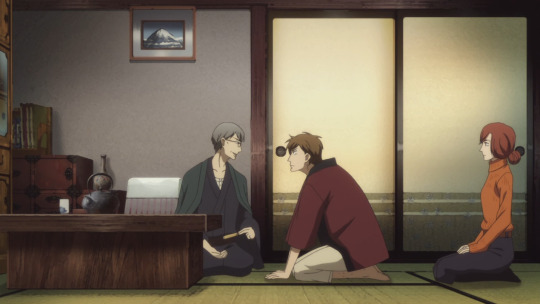
Our unreliable narrator begins to tell his story
Of course, we are later told that Kiku, or after this point Yakumo is an unreliable narrator, ironic, being that the person who is described in the series as the best storyteller being unreliable to us.
There is one more concept we need to understand and use in understanding how to make tradition evolve and live on, and that is Repetition and difference from Gilles Deleuze; when used together with Butler’s performativity, it can help us greatly in this journey of understanding.
That will be our focus in the next chapter.
But to end this chapter, let us end it off with this consideration. With Sukeroku’s death, Yakumo completely lost his faith in Rakugo having a future. This leads to him both refusing to take any disciple, and also prevent Konatsu from trying to practice it. This obsession also leads to him being convinced that it was his destiny to witness the death of this practice, thus the title, to commit double suicide with Rakugo during the age of Showa Genroku.
Role credits
#Anime analysis#showa genroku rakugo shinju#yuurakutei yakumo#yuurakutei sukeroku#sgrs#Sukeroku Yuurakutei#Yakumo Yuurakutei
24 notes
·
View notes
Text
More SGRS EXTRAS Guys.

Real precious grandson and grandfather reunion moment here.
#shouwa genroku rakugo shinjuu#showa genroku rakugo shinju#shinnosuke#yuurakutei yakumo#Yakumo Yurakutei#kikuhiko#haruko kumota#kumoto haruko#manga series#manga scan#manga#sgrs#sgrs spoilers#manga caps#manga related
118 notes
·
View notes
Photo
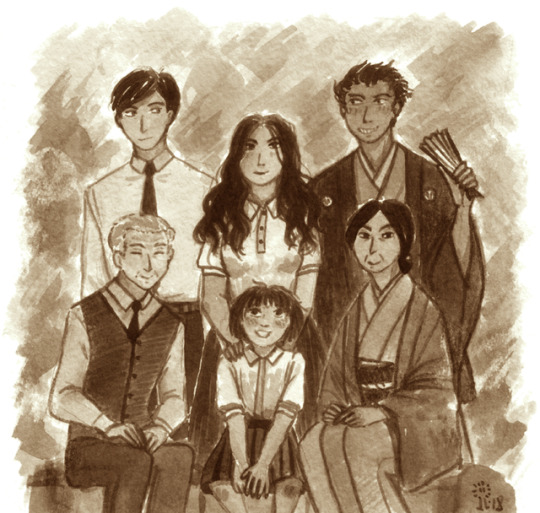
i’m fully aware: happiness and misfortune
pass in a moment’s breath
#inktober#inktober 2018#shouwa genroku rakugo shinjuu#sgrs#kumota haruko#inspired by hayashibara's official music video for 'usurahi shinjuu'#and an old photo of my grandmother's family#yuurakutei yakumo#kikuhiko#miyokichi#yuurakutei sukeroku#shin#matsuda#konatsu#okami-san#Pure Pain™#the paper refused to cooperate#ink
200 notes
·
View notes
Text
How do I put it into words...?
The majority of the fandom has probably watched the last episode, so now might be fitting to get this out of my chest. I don’t normally do stuff like this, but since everyone is doing the same, I feel like I have to. I’m too exasperated to keep it in.
Shouwa Genroku Rakugo Shinjuu is such a wonderfully crafted tale. There’s so much symbolism and so many readings between lines that it’s impossible to count all. Everything connects, everything makes sense and everything comes in a cycle. It’s beautifully executed; the animation studio did a great job. It also delivered a proper, representative ending where all of it culminates together. Pretty perfect, I must say, except for one thing (yes, this is exactly what you think).
And since this one thing includes spoilers, the rest will be left under the cut.
I’ll be direct: the implication that Shinnosuke might be Kikuhiko’s son is just too much for me to handle. I would have mindlessly discarted it first-thing if it had been thrown in a meaningless manner into the episode, but no, it was almost a confirmation. Too many calculated details were placed in there - such that would have absolutely not been necessary were it just a “what-if” scenario. The fact that it was even speculated in the first place is already a huge indicator that it has more chances of being true than something Yotarou merely assumed upon seeing Konatsu cry. After all, this and the way Shinnosuke resembled his supposed father when small were the only hints we ever had of Kido Isao being “the one”. As for Kiku, aside from the aforementioned, we had:
Shinnosuke looking like a carbon copy of Kiku with wavy hair (specially after growing up).
Konatsu refusing to talk about it. There would be no reason for her to not do so if Kiku weren’t the father, since she simply let everyone assume that the real one was Isao.
One of Konatsu’s motives for giving birth to Shinnosuke being that she had wanted Kiku to be happy that he had not let go of rakugo.
Kiku swore to himself he would never have a wife because of what he had unknowingly done to Yurie, but in several previous episodes, it’s been proved that he sees Yurie in Konatsu. This also means that Konatsu was the only one that could have prevented his lineage from dying out after he passed away, as she was the closest that anyone would ever get to being a candidate for sleeping with him.
Konatsu implying she was very likely in love with Kiku during her younger days.
Higuchi asking if Yotarou or Shinnosuke “knew about any of that”, suggesting that there was something they had to know. Something that definitely wasn’t Isao being Shinnosuke’s father, because Yotarou already knew this.
Konatsu answering that she would not tell them about any of it because she didn’t want to throw water in their relationship, even though said relationship was not disturbed in the slightest by the thought that Isao could have been Shinnosuke’s father.
Again, let’s go back to why Yotarou believes Shinnosuke to be Isao’s son: he saw Konatsu coming out of the room Isao was in with teary eyes. The most possible cause was that Isao had pressed her on to reveal if he was Shinnosuke’s father or not. Before that exchange, Konatsu had talked with the mistress, who had commented that she “resembled Miyokichi-san a lot”, except in the fact that she had a strong sense of integrity. At that moment, Konatsu was looking like shit (you can guess why). Supposing that Kiku is Shinnosuke’s father, when Konatsu had to tell the mistress and Isao about it, she must certainly have felt extremely humiliated. Not only because that was her foster parent she had slept with, but it was also the man she hated and that had, in her head, killed her parents. I can only imagine the faces the two would have made at her if the scene had been animated. That would be a much clearer explanation for her tears, as well as why she had included Isao and the mistress as two of the four people that knew the truth about Shinnosuke.
But now you may be wondering, “but then why was the matter left in open?”. It actually was more confirmed than not, but ultimately, Konatsu didn’t really put it in words, so the spectators are left to take their own conclusions. What might have motivated the author to choose this route is quite simple. Taking the entire story into consideration, from the perspective of a writer, the idea of a child carrying the blood of both Sukeroku and Kikuhiko is too seductive to discart, but Kumota Haruko was probably aware that most fans would not go along with this. It’s highly disgusting to have one of the protagonists, who was at that point an elder, sleep with a much younger woman that was also the daughter of his late best friend and ex-girlfriend, and whom he himself had raised. And, who knows, maybe Haruko-sensei herself also wasn’t too proud of it. Hence the “open” ending.
I unironically applaud her for how much thought and care she put into this half-revelation. It was extremely well-planned, down to the very last element, just like every other bit of the manga. Still, it leaves a really bitter taste in my mouth. The only way I can not let that completely ruin Konatsu and Kiku for me, as well as the rest of the story, is to ignore it. And that is furstrating as hell.
I mean, sure, fictional characters aren’t made to fit our moral agenda, but that doesn’t mean something so deeply disturbing wouldn’t gross most of us out.
#shouwa genroku rakugo shinjuu#shouwa genroku rakugo shinjuu 2#konatsu#kikuhiko#sukeroku#shinnosuke#yakumo#yotaro#miyokichi#sgrs#yurie#higuchi eisuke#kumota haruko#anime#shouraku
131 notes
·
View notes